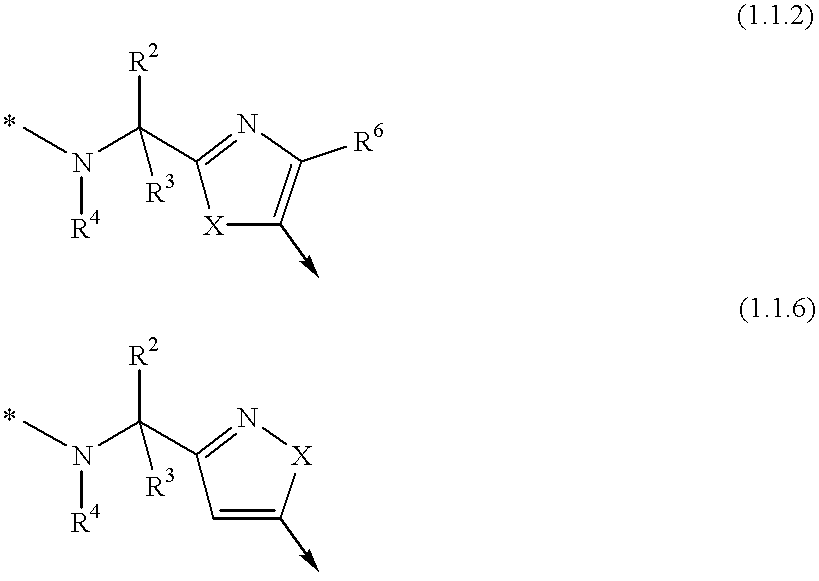Non-peptidyl inhibitors of a VLA-4 dependent cell binding useful in treating inflammatory, autoimmune, and respiratory diseases
a vla-4 dependent, non-peptidyl inhibitor technology, applied in the field of peptide vla4 antagonists, can solve the problems of reducing the chance of appreciably absorbing the effect of peptidyl inhibitors, and prone to poor absorption
- Summary
- Abstract
- Description
- Claims
- Application Information
AI Technical Summary
Problems solved by technology
Method used
Image
Examples
example 2
A. 3-[3-(3-Methyl-1-{2-[4-(3-o-tolyl-ureido)-phenyl]-acetylamino}-butyl)-isoxazol-5-yl]-propionic acid
##STR88##
A mixture of 3-[3-(3-methyl-1-{2-[4-(3-o-tolyl-ureido)-phenyl]-acetylamino}-butyl)-isoxazol-5-yl]-propionic acid methyl ester (17 mg) in tert-BuOH (1 ml) and 0.1 N NaOH (1 ml) was stirred at room temperature. After 20 h the mixture was concentrated under reduced pressure, dissolved in water (5 ml) and extracted with EtOAc (5 ml.times.3). The aqueous layer was then acidified to pH 3 with IN HCl and extracted with EtOAc. The combined organics were washed with brine; dried over Na.sub.2 SO.sub.4 ; filtered and concentrated under reduced pressure to give the title compound as a white amorphous solid. MP=?; MS [M+1]+493.2; .sup.1 H nmr (400 MHz, CD.sub.3 OD) .delta.0.87 (d, 3H), 0.91 (d, 3H), 1.53-1.66 (m, 3H), 2.26 (s, 3H), 2.64 (t, J=7.4 Hz, 2H), 2.97 (t, J=7.5 Hz, 2H), 3.44 (s, 2H), 5.08 (m, 1H), 6.00 (s, 1H), 6.99 (t, 1H), 7.11-7.36 (m, 6H), 7.59 (d, J=7.9 Hz,1H).
B. 3-[3-(3-...
example 3
A. [2-(3-Methyl-1-{2-[4-(3-o-tolyl-ureido)-phenyl]-acetylamino}-butyl)-4,5-dihydro-oxazol-5-yl]-acetic acid
##STR93##
A mixture of [2-(3-methyl-1-{2-[4-(3-o-tolyl-ureido)-phenyl]-acetylamino}-butyl)-4,5-dihydro-oxazol-5-yl]-acetic acid benzyl ester (120 mg) and palladium hydroxide (40 mg) in 10 ml of THF and 10 ml of MeOH was shaken on a Parr Apparatus under 30 p.s.i. H.sub.2 for 2 h. The mixture was filtered through Celite and the filtrate concentrated under reduced pressure. The residue was suspended in EtOAc and concentrated under reduced pressure. Trituration with hot EtOAc gave 93 mg of the title compound as a light pink solid. MS [M+1]+481.3; .sup.1 H nmr (400 MHz, DMSO-d.sub.6) .delta.0.77-0.87 (m, 6H), 1.39-1.59 (m, 3H), 2.10-2.33 (m, 4H, including s at 2.21, 3H), 2.40-5.08 (m, 7H, including q at 3.36, J=14.2 Hz, 2H), 6.90 (t, J=7.4 Hz, 1H), 7.08-7.14 (m, 4H), 7.35 (d, J=6.8 Hz, 2H), 7.79 (d, J=8.1 Hz, 1H), 7.95-8.45 (m, 2H), 9.13-9.23 (m, 1H).
B. [2-(3-methyl-1-{2-[4-(3-o-toly...
example 4
A. (3-Benzyl-2-oxo-4-{[4-(3-o-tolyl-ureido)-phenyl]-acetyl}-piperazin-1-yl)-propionic acid
##STR101##
A solution of 3-(3-benzyl-2-oxo-4-{[4-(3-o-tolyl-ureido)-phenyl]-acetyl}-piperazin-1-yl)-propionic acid tert-butyl ester (0.7 g) in 10 ml of 4N HCl / dioxane was stirred at room temperature. After 2 h the solution was concentrated under reduced pressure and the residue was dissolved in 1N NaOH (50 ml) and extracted with EtOAc (20 ml.times.2). The aqueous phase was acidified to pH 2 with 6N HCl and extracted with EtOAc (20 ml.times.3). The combined organics were washed with brine; dried over Na2SO4; filtered and concentrated under reduced pressure to give 0.54 g of the title compound as a white amorphous solid. MP=103-5.degree. C.; MS (M-1) 527.
B. (3-Benzyl-2-oxo-4-{[4-(3-o-tolyl-ureido)-phenyl]-acetyl}-piperazin-1-yl)-propionic acid tert-butyl ester
##STR102##
The title compound (white amporphous solid; MS (M-1) 583.4) was prepared in an analogous fashion to Example 1B, utilizing 3-(3-ben...
PUM
| Property | Measurement | Unit |
|---|---|---|
| body weight | aaaaa | aaaaa |
| body weight | aaaaa | aaaaa |
| body weight | aaaaa | aaaaa |
Abstract
Description
Claims
Application Information
 Login to View More
Login to View More - R&D
- Intellectual Property
- Life Sciences
- Materials
- Tech Scout
- Unparalleled Data Quality
- Higher Quality Content
- 60% Fewer Hallucinations
Browse by: Latest US Patents, China's latest patents, Technical Efficacy Thesaurus, Application Domain, Technology Topic, Popular Technical Reports.
© 2025 PatSnap. All rights reserved.Legal|Privacy policy|Modern Slavery Act Transparency Statement|Sitemap|About US| Contact US: help@patsnap.com



